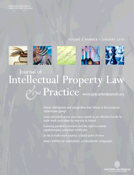 The contents of issue 1 of the Journal of Intellectual Property Law and Practice for 2010 are now available in full online (click here for details). We hope that you will like this year's smart new cover colour, a rather fetching silvery grey. A further 13 articles, notes and reviews which are due to be published in future issues can be read by subscribers now through JIPLP's Advance Access facility.
The contents of issue 1 of the Journal of Intellectual Property Law and Practice for 2010 are now available in full online (click here for details). We hope that you will like this year's smart new cover colour, a rather fetching silvery grey. A further 13 articles, notes and reviews which are due to be published in future issues can be read by subscribers now through JIPLP's Advance Access facility.The Editorial (which we reproduce in full below) asks questions about the role of evidence -- which is increasingly demanded by those who ask whether IP systems actually work.
Where's the evidence?
The importance of evidence in IP law has never been doubted. In patent law, a bare unsubstantiated allegation that an alleged invention has been anticipated by a prior disclosure or that its obvious in the light of earlier knowledge will not succeed unless it is supported by evidence as to what was in the prior art, from what date, and to whom it was accessible. In trade mark law, even such speculative notions as the likelihood that a consumer, faced with a branded product, will confuse it with another must be based on evidential principles, not mere surmise. That evidence is needed is not unique to IP law; however, it is part of the common heritage that is reflected in almost all laws in every jurisdiction.
A second tier of evidence concerns IP law at the point at which its efficacy is questioned in the light of its accepted aims: if you want to prove that the law is inadequate to achieve those aims, bare assertion is again unacceptable. Thus, when owners of copyright in sound recordings and the works incorporated in them complain that their financial investment and economic wellbeing has been damaged by piracy or unauthorized downloading or file-sharing, when pharmaceutical companies object that the delicate balance of their R&D ecosystem is threatened by compulsory licensing or competition from manufacturers of generics, or when brand owners demand security from the depredations of lookalike and now smell-alike products, both national and now international bodies ask: show us the proof. Wild guesstimates by victims of infringements are no longer uncritically welcomed. The world demands something more than that.
Most recently, a third tier of evidence has been called for. This relates to fundamental questions such as proof of whether the various IP rights, and particularly the patent system, actually work. Calls for proof have been made recently in the UK, where the government is determined to re-think many areas that have previously been taken for granted, and beyond.
The first problem to be faced is that you have to know what you're proving before you can prove it. If you believe that the patent system's objective is (i) to incentivise invention, (ii) to protect innovative investment, (iii) to encourage the disclosure of new scientific data or anything else, you will need different evidence.
The second problem is the level of proof which is required. Most registered patents, trade marks, and designs would appear not to be exploited profitably and successfully by their owners. Clearly, if every such right resulted in a commercial jackpot we would feel that the system was working while, if no registered right ever did, we might be forgiven for thinking that protection systems based in registration were a waste of time. But what is the ‘right’ level of success that justifies the system: 90%? 60%? 30%?
The third problem is that, when compiling evidence, some subject-matter is more amenable of quantification and, when we talk of IP rights that are exercised in the market place, that quantification is generally economic. While the economic analysis of the role played by individual IP rights, and by the system as a whole, gives some evidence as to economic performance, it gives little clue as to the system's moral worth. Yet moral notions such as the fact that it is wrong to steal or to copy can be found at the heart of both the rights themselves and the way the courts deal with them. In copyright, some rights are specifically described as ‘moral rights’ because there is no economic basis for them: the right to be acknowledged as the author of one's work, the right to object to its mutilation by others, and so on. How does one show that rights such as these are ‘working’?
The fourth (but probably not final) problem is that any yardstick by which economic performance measures IP rights is likely to inherently inimical to them insofar as the accepted economic wisdom of the day is not warmly receptive to the sort of control that those rights can impose upon the markets in which they are used.
It would be pleasant to say that the unparalleled rate of technological advance in every sphere, the upsurge in consumer choice, the ever-widening range of products and services to match every need and the explosion of available knowledge, understanding, and opinion are all the fruits of the IP system as we have it today, but no appeal to the self-evident truth will withstand the demands of legislators today.
No comments:
Post a Comment